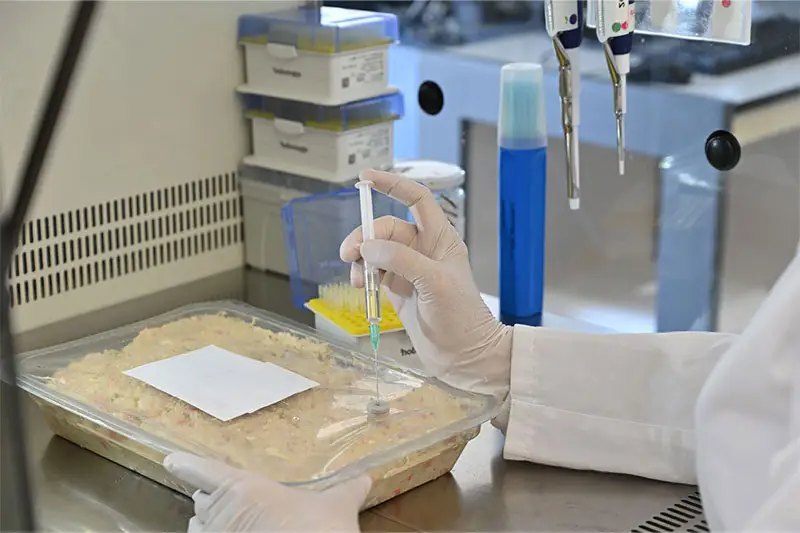Pseudomonas Aeruginosa Detection in Eye Cosmetics Testing
The presence of Pseudomonas aeruginosa can be a significant concern in the formulation and manufacturing processes of eye cosmetics. This bacterium is not only prevalent but also highly adaptable, making it one of the most common causes of ocular infections worldwide. Eye cosmetics, especially those with prolonged contact time and water-based formulations, provide an ideal environment for bacterial growth.
Microbiological safety testing plays a pivotal role in ensuring that cosmetic products meet stringent regulatory requirements. In the case of eye cosmetics, the focus is on preventing contamination by opportunistic pathogens like Pseudomonas aeruginosa. The World Health Organization (WHO) and the United States Food and Drug Administration (FDA), among other global bodies, have established guidelines to ensure that such products do not pose a risk to public health.
Given its potential to cause serious infections leading to corneal ulceration and vision loss, Pseudomonas aeruginosa is closely monitored in cosmetic formulations. The American Society for Testing and Materials (ASTM) E2548-17 standard provides a framework for microbiological safety testing of eye care products.
The process involves several steps to ensure accurate detection:
- Sample collection: Properly collecting the sample is critical. This includes using sterile techniques and ensuring that the sample is not contaminated during collection.
- Preparation: The sample must be prepared according to specified protocols, which may involve dilution or other steps to ensure accurate detection.
- Culture media: Appropriate culture media should be used for growing bacteria. This helps in differentiating between various species and identifying the presence of Pseudomonas aeruginosa.
- Incubation: The sample is incubated under conditions that favor bacterial growth, allowing for detection.
The use of advanced laboratory techniques such as polymerase chain reaction (PCR) can also be employed to detect the presence of Pseudomonas aeruginosa. PCR allows for rapid identification and quantification of genetic material specific to this bacterium. This method is highly sensitive and specific, making it an invaluable tool in microbiological safety testing.
Once detected, appropriate measures must be taken to ensure product safety. These may include reformulating the product or implementing additional sterilization steps during production. Regular monitoring through microbiological testing helps maintain product quality and compliance with regulatory standards.
Why It Matters
The importance of detecting Pseudomonas aeruginosa in eye cosmetics cannot be overstated. Failure to do so can lead to severe health risks for consumers, particularly those who have weakened immune systems or pre-existing ocular conditions.
- Health Risks: As mentioned earlier, infections caused by Pseudomonas aeruginosa can result in corneal ulceration and potentially lead to vision loss.
- Liability Issues: Non-compliance with regulatory standards can lead to product recalls, financial losses, and damage to brand reputation.
- Consumer Trust: Ensuring product safety builds consumer trust, which is crucial for the success of any cosmetic brand.
In addition to these immediate concerns, detecting Pseudomonas aeruginosa early in the production process can help prevent costly recalls and product withdrawals. This proactive approach not only protects consumers but also ensures that brands maintain their commitment to quality and safety standards.
| Regulatory Standards | Testing Methodologies |
|---|---|
| ISO 16482:2017 | Culture-based methods |
| ASTM E2548-17 | PCR-based detection |
The inclusion of these standards in the testing process ensures that results are reliable and consistent, meeting international regulatory requirements.
International Acceptance and Recognition
The detection of Pseudomonas aeruginosa is recognized by several international bodies and standards organizations. These include the International Organization for Standardization (ISO), ASTM, and the European Committee for Standardization (CEN).
- ASTM E2548-17: This standard provides a comprehensive guide on how to conduct microbiological testing of eye care products. It covers everything from sample collection to final reporting.
- ISO 16482:2017: This international standard sets out the methods for microbial limit tests in cosmetic products, including those used around the eyes. It emphasizes the importance of accurate and consistent testing.
Compliance with these standards is not only a legal requirement but also an indicator of a company's commitment to quality and safety. Many countries and regions have adopted or referenced these standards in their own regulations. For example, the FDA requires that all cosmetic products, including those for ocular use, be free from harmful microorganisms like Pseudomonas aeruginosa.
Recognizing the global nature of the cosmetics industry, many companies opt to adhere to international standards. This ensures that their products meet the highest quality and safety benchmarks regardless of where they are sold.
Use Cases and Application Examples
- New Product Introduction: Before launching a new eye cosmetic product, companies must ensure it is free from harmful bacteria. This involves thorough microbiological testing to comply with regulatory standards.
- Ongoing Quality Assurance: Regular sampling and testing help maintain the quality of existing products by identifying any potential issues early on.
- Batch Release Testing: Each batch produced must pass strict microbiological safety tests before being released to market. This ensures consistency in product quality across all batches.
| Testing Scenario | Expected Outcome |
|---|---|
| New product introduction for an eye serum formulated with botanical extracts. | Positive detection of Pseudomonas aeruginosa, leading to reformulation and additional sterilization steps during production. |
| Ongoing quality assurance for a line of contact lenses. | No detectable levels of Pseudomonas aeruginosa, ensuring continued product safety. |
| Batch release testing for a multi-pack of eye makeup remover wipes. | Negative results in all batches, confirming compliance with regulatory standards. |
The real-world application of these tests demonstrates the critical role they play in ensuring product safety and maintaining consumer trust. By adhering to international standards and implementing robust testing protocols, companies can effectively prevent contamination and ensure that their products meet high-quality benchmarks.





